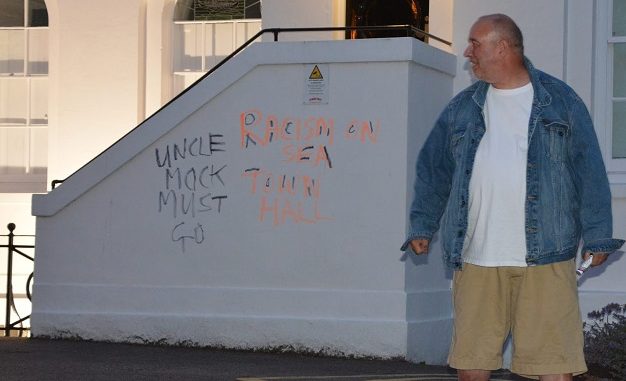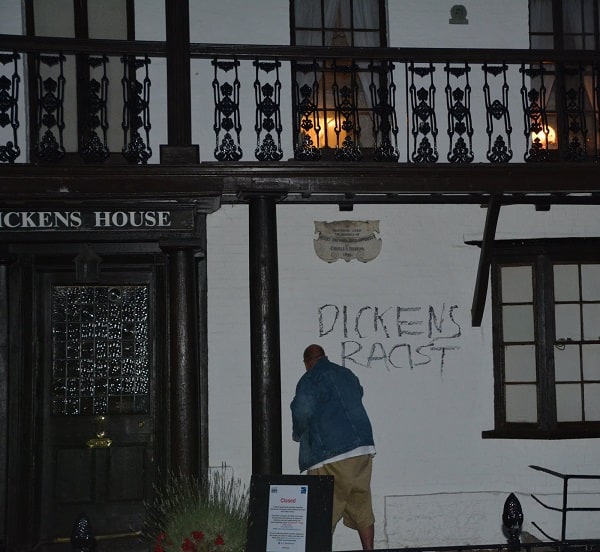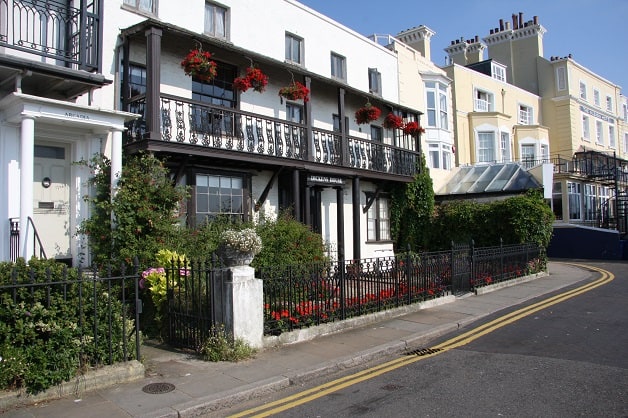
Former councillor Ian Driver has admitted to being responsible for a series of anti-racism graffiti tags in Broadstairs and Ramsgate.
The Broadstairs resident, who is already under investigation after spray painting the protective box covering the Uncle Mack memorial in Broadstairs following a Black Lives Matter demonstration in Broadstairs on June 13, says his latest act is in response to a Broadstairs Town Council recommendation to retain the Uncle Mack memorial despite issues of black facing racisim and, Mr Driver says, Thanet council’s “woefully inadequate review of its publicly funded racist properties and activities.”
Mr Driver sprayed graffiti on Broadstairs and St Peter’s Town Council offices at Pierremont Hall, the office of the Broadstairs Folk Week, the Thanet council owned Dickens Museum, the box protecting the controversial Uncle Mack memorial plaque and two street signs in Broadstairs and Ramsgate.

In a blog post Mr Driver writes: “I selected the targets as they represent the deep-rooted institutional racism of Broadstairs Town and Thanet District councils and the Broadstairs Dickens Week and Folk Week charities who openly support, celebrate, and fund with public money, offensive blacked up Morris dancers, Uncle Mack’s blacked up Minstrel show memorial, and genocidal racists such as Charles Dickens and King Leopold of Belgium.”
He adds: “My actions are nothing to do with the Black Lives Matter movement, of which I am a supporter, and are purely part of my own individual protest for which I alone am responsible.
“Peaceful direct action, such as graffiti, the destruction and defacing of offensive statues and memorials has always been, and always will be, a legitimate part of protest and social change and was used extensively by the suffragettes, the anti-poll tax, anti-fracking, and climate change movements in the UK, and national liberation struggles the world over.”
Mr Driver added: “I have no regrets and will be making no apology. I did the right thing and would do it again if needs be.”
‘Mindless individual’

However Chairman of the Broadstairs Dickens Fellowship, Eddy Coulson, has branded the graffiti “mindless” and disputes the claims of racism laid by Mr Driver.
Mr Coulson said: “Dickens House Museum, for 47 years a Broadstairs Town asset donated by Dora Tattam whose family lived there from 1919 until it was bequeathed to the town Dickens called “Our English watering place.” in 1973.
“Sadly it has been vandalised by a mindless individual with no regard for a cultural asset nor someone possessing any grip on reality. The charge that Dickens was a racist is not one I fully support. Lauded by an admiring American public, following his first visit in 1842, when he was only 30, he was subsequently lambasted by them for the things he wrote about his experience there.
“In his book American Notes Dickens does not hold back on those elements of the American way of life with which he takes issue. Principal amongst which was Dickens’ abhorrence of the treatment of black people held as slaves. Such was the antipathy towards Dickens he did not return until 1868. Dickens wrote “The upholders of slavery in America- of the atrocities of which system I shall not write one word for which I have not had ample proof and warrant- may be divided into three classes.”.
“The first can be described as slave owners who wish to be benign but carry on their trade until their own “Day of Judgement.”. The second class are those who see no evil in their activities and will go to war “civil or foreign” to protect their slave buying and selling. The last group, “not the least numerous or influential” state that public opinion rules slavery legal and if public opinion wishes to end it, no doubt public opinion will.
“Dickens visited Broadstairs from 1837 until 1859. The debate about whether Charles Dickens was a racist has persisted for as long as his books have been read. You cannot expunge from history some of the offensive things he has said and written. What must happen is an assessment of the good things he did versus the bad. For my part, as the Chairman of the Broadstairs Dickens Fellowship, I believe that he did more by way of improving the society in the time in which he lived than harm it otherwise. There exists a host of writing on the subject of whether he was a racist or otherwise. However, 150 years after the death of Dickens what is he best remembered for? Any chance of a serious debate is not enhanced by mindless graffiti being daubed on perhaps the town’s best cultural asset.”

